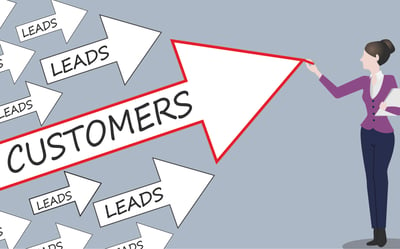
Generating leads isn’t just a priority for small businesses and startups anymore.
Corporations and larger businesses need to keep up with growth and profitability targets by bringing in new customers with the increasing competition from smaller rivals. A good lead generation engine can deliver outsized results and set the business to grow for several years.
The good news is with the rise of digital marketing channels and distribution, there are now more ways to generate leads.
So how do you start generating leads for your business? Let’s first explore what lead generation is all about.
B2B lead generation is the process of capturing the attention of intent-rich leads so that they can be reached out and nurtured for sales. It starts with marketing activities that help generate interest from a targeted audience of potential buyers who convert into “leads” qualified based on predefined criteria.
Lead generation helps materialize demand by filling up the top funnel of your customer acquisition process. These leads are potential customers and opportunities for closure in the sales pipeline. This makes B2B lead generation a crucial first part of your sales process since your outcomes hinge on the success of your lead generation efforts.
Leads generated using B2B lead generation processes are segmented into marketing qualified leads (MQLs) and sales qualified leads (SQLs). Let’s dive deeper and understand where they fit in the process.
Leads that fit your buyer persona based on their engagement with your marketing activities are defined as marketing qualified leads. Target audience and visitors on marketing assets are filtered through a low-touch qualification process, converting them into MQLs.
MQLs are usually looked after by marketing teams responsible for generating and qualifying the leads.
Sales qualified leads (SQLs) are MQLs qualified by sales teams for strong buying intent. SQLs are generated so that the sales team can prioritize and focus on the leads that are most likely to convert. This approach is useful, especially when products have longer sales cycles, where nurturing the wrong leads could impact conversion rates negatively.
SQLs are qualified and scored based on predefined criteria, similar to MQLs, but involve the sales team’s effort to vet each SQL. SQLs can be qualified based on frameworks like BANT, MEDDIC, CHAMP, and others.
We’ve learned about the different types of leads and their role in the sales process. But how exactly does B2B Lead Generation impact your team and define the outcomes of your sales process?
B2B lead generation sits at the heart of sales development – it helps build up and convert demand for a product. Without a lead generation process in place, your team wouldn’t generate leads, and as a result, have an empty sales pipeline.
This would mean your sales reps wouldn’t have leads to reach out, nurture, and close. Operating a sales team without a pipeline full of leads will also leave you incapable of projecting sales and profits, which would have ripple effects across your entire organization.
Lead generation is a top concern for management and executive teams in general. This can have a tremendous impact on the revenue.
Generating predictable volumes of high-quality leads can arm your sales team with more opportunities to close and generate more revenue. This is why it’s one of the most crucial parts of customer acquisition and revenue growth processes.
So how do you generate more leads for your business to keep your sales growing? Let’s find out.
Lead generation depends on marketing channels and platforms to access audiences on each of these channels. But all lead generation channels can primarily be categorized into two types: inbound marketing and outbound marketing.
Inbound marketing consists of platforms and channels that generate leads from traffic sources like search, social media, online advertising, and so on.
Visitors to your inbound channels approach you or sign up for your product or offer, which can be used as a proxy for buying intent. Inbound leads have a higher rate of conversion and shorter sales cycles.
Outbound marketing and sales consist of generating leads by conducting outbound outreach to cold leads. This is done on outbound channels like phone, email, social prospecting, and more.
Outbound marketing requires leads to be qualified before being approached. After an outbound lead responds or engages, they also need to be engaged. This makes outbound marketing ideal for selling big-ticket products with longer sales cycles.
We mentioned earlier how inbound marketing helps drive visitor traffic to your marketing assets and converts them into MQLs.
Organic search brings 29% of inbound web traffic, the second-largest channel. This reinforces the impact of SEO – the practice of creating and distributing content specifically for the sake of gaining search visibility.
Content marketing is also part of inbound marketing efforts and involves publishing and distributing relevant, topical content focused on gaining search traffic.
Typical content marketing and SEO activities include keyword research, competitor and topic research, writing, and distributing content. The goal of the entire process is to find keywords that could drive visitors with buying intent and eventually nurture and convert them using your content. Understanding key SEO metrics is also crucial to measure the effectiveness of these efforts and continuously optimize them.
Potential keywords can be found using search and keyword analytics tools narrowed down based on buying intent and made part of your blog and landing page content.
And it generates results, slowly but surely.
CBIZ booked additional $100,000+ in revenue by generating leads from SEO traffic.
Source: Brightedge
The popularity and reach of social media and search have made them a lucrative avenue for advertising. Apart from a sizable audience, these platforms also boast targeting and bidding features that make it easier to attract qualified leads.
Paid ads help you drive traffic and generate leads almost instantly, unlike organic inbound channels. As the name suggests, paid ads come with an acquisition cost attached to every lead you generate. And based on various factors, results from your ad campaigns could swing in either direction.
This is why budgeting is really important to run successful ad campaigns. Account for metrics like your customer lifetime value (CLV), existing product margins, and traffic conversion rates, along with your planned cost per lead (CPL). If your acquisition costs outweigh these metrics, you’ll end up losing money on your leads, which wouldn’t be very sustainable.
Incapsula, a B2B cybersecurity SaaS company, leveraged paid acquisition channels to generate a high volume of qualified leads. Using Google’s paid search ads, they generated an additional $2.9M in revenue, with a 1019% increase in customers and conversions.
Email is one of the best converting and cost-efficient acquisition channels. It generates $36 in revenue for every $1 spent. The same can’t be said for other channels.
Email marketing is the process of nurturing your email leads throughout their journey to get qualified as an MQL or convert low-touch eventually. To run email marketing, you’d need a list of leads to connect. These leads can be captured through gated content, newsletter subscription, or trial signups.
To make the most out of your email marketing campaigns, you can use a few best practices that’ll improve your email open and click rates.
Personalizing subject lines in your email with information such as name, use cases, and features helps your emails stand out and open more. Similarly, omit as much HTML in your email as possible, as extensive use of HTML can trip spam triggers and get your emails delivered to junk and spam folders.
Apart from this, also ensure only to send out relevant content to your leads. If your content doesn’t resonate with your email audience, your engagement rates will eventually decline. A higher engagement rate is essential to keep your leads aware of your product and brand.
Interest-based communities around products and problems have grown in popularity since they make for a great peer network and support channel. Groups like these are built on the premise of solving problems for the members, which in itself is a good qualifier for product fit.
Large, engaged communities built around your customers’ problems and pain points can serve as a budding ground for evangelists and power users.
You can find such communities on Facebook, Slack, and Reddit, where people come together to discuss and find solutions to problems specific to a product, category, or industry.
Look for groups in your industry with a healthy amount of members and engagement, where you can start joining discussions and talk about your product. Or, you can build your own community set around problems or use cases your customers typically face.
You can start pushing your existing customers and potential customers to join your community and build an audience of engaged leads.
WordPress Experts, a public Facebook group with over 52,000 members, is a great example. It’s set up to attract and host WordPress developers who might face problems, so they can consult with other developers and experts. Building such a group will help amass a large audience, which you can later leverage to sell products.
Building an audience can be tough, especially when starting from scratch. By partnering up with other businesses, you can tap into their customer base and generate leads for your business.
Affiliates, agencies, service providers, distributors, and influencers all have existing audiences with characteristics overlapping with your ideal customers.
When you come across businesses you could potentially partner up with, qualify them for a proper fit with your audience. Make sure their audience is well engaged and can find your product relevant.
When setting up a partnership, structure the specifics to benefit both parties without risks or upfront costs. A barter-style deal works the best, where both parties can access each other’s audiences and generate leads without any material costs involved.
Let’s look at the Apple Pay + Mastercard partnership. When Apple Pay launched for iOS users, Mastercard took the opportunity and became the first card processor to allow its users to store their cards on Apple Pay. This helped Mastercard increase their transaction volumes and engage dormant customers by enabling them to use a more popular service like Apple’s.
When you reach out to a potential lead yet to interact with you or your product, you’re reaching out to them cold. And cold calling has been one of the most popular ways to prospect and generate leads since phone numbers have been easily accessible.
Most C-level and VPs within companies (57%) prefer to be contacted by phone over other channels. This makes it one of the best channels to connect with decision-makers within larger corporations if you’re selling enterprise solutions.
You can either use services like Yellow Pages or look for other online services selling telephone leads. If you’re selling to local businesses, you can also look for their phone numbers on Google Maps and Yelp.
Cold calling is quickly going out of date since carriers and smartphone apps have made it easier to block promotional calls. Most customers and prospects don’t want to be bothered by cold callers, so getting thorough and pitching your product wouldn’t be as easy. But you can try to connect with leads in a semi-warm way.
Say, for example, talk about their business first before you get to your agenda. This will help you get your foot in through the door and make it easier to convert potential customers into leads.
Like cold calls, you can reach out to potential customers using emails to build engagement. Outreach emails can be used to both generate new leads and nurture them based on your needs. But unlike cold calls, emails can be automated using sales engagement tools and set up in a sequence to send follow-ups.
Cold email sequences help improve response rates for outreach campaigns and move your leads to the next stage in the sales cycle.
Marketing emails with personalized messages saw an 18% open rate compared to 13% otherwise, resulting in a 38% improvement. This increase in engagement consequently results in more opportunities and leads being generated.
To conduct cold email campaigns and generate leads, you’ll first have to find an email. You can use platforms like Linkedin to find these leads and capture their emails using email finding tools.
Once you’ve captured your leads’ emails, you can then start reaching out to them and add them to your pipeline based on their engagement.
In the above cold email, the sales rep reaches out to the lead reacting to an industry event. They’re pitched on a solution to help the lead offset a problem and explore ways to generate more revenue.
The email is well personalized for the leads’ business, making the message more likely to be opened. Once the lead books a call or opens the email, they’d then be converted into a prospect and moved into the sales pipeline.
Social selling is the practice of actively engaging and interacting with your potential customers on social channels.
Your audience is fragmented across different parts of a platform, and social selling helps find and engage people who might need your product. This is done by interacting with groups and posts with your product or a problem your product solves as part of the discussion.
The above example demonstrates social selling really well. When one of the users left a positive experience with a product, the founder made it a point to leave a reply. This not only made the user more likely to buy the product, but it also stretched the message’s reach to far more people. In this case, a good review of the product gets seen by more people, who’ll consider signing up for the product in the future.
Generating and tracking conversions directly from your social channels can be tricky. One way to capture leads from social media is by directly linking your landing page to your post content.
Similarly, you can also leave your email address or keep your DMs open for leads to approach you within these platforms. The end goal would be the ability to interact directly and engage with your leads through email, DMs, or phones.
Account-based marketing (ABM) is a sales prospecting and nurturing approach that emphasizes accounts rather than leads and prospects.
Accounts are target organizations and teams that would buy from you. Hence, you’ll have multiple potential customers or leads of interest at your target account. Sales and marketing teams work together to find potential customers within a target account and reach out to them.
ABM is really useful when you’re selling big-ticket products to enterprise customers who need multiple decision-makers to let a sale go through.
By dedicating resources to nurture every potential customer inside a target account, you’re maximizing your chances of closing a large-sized deal. This helps shrink the long sales cycles typically involved with selling big tickets and find all the decision-makers within the account.
Typical ABM processes involve research into target accounts, personalized outreach, regular follow-ups, meetings, updates, etc. Each of these activities helps qualify leads into the next stage of the sales cycle and get them closer to buying.
SAP, the ERP software giant, leveraged ABM strategies to nurture a large directory of leads and ended up adding $27 million in new opportunities.
When your sales team is reaching out cold to potential customers, conversions and engagement are likely low. This is one of the drawbacks of cold outreach since your leads don’t know you or trust you.
But when cold outreach is combined with content resources like case studies, presentations, blogs, videos, etc., it increases conversions. Sales enablement has been observed to increase sales by 6-20% for 76% of organizations.
Apart from cold outreach, sales enablement content can also be placed in channels already generating traffic. These channels can include landing pages, newsletters, onboarding emails, social media posts, and so on. When developing sales enablement content, focus on outcomes for your customers.
Position your product and its solutions in line with your ideal customers’ profile and the pains they face. Also, use numbers to quantify your product’s impact to calculate ROI on your product. This makes it easier for your potential customer to make a buying decision, consequently converting them into a lead, and later, a customer.
Many of these lead generation channels and strategies wouldn’t seamlessly work until you pair them up with tools and services.
Here are the different tools you’ll need to generate leads using the methods we listed above.
When you’re prospecting for leads on social platforms, you don’t really have a way to connect with them over email. This is where you’ll need to use email-finding tools to capture their email addresses, so you can proceed with adding them to your cold outreach sequences.
Some tools might offer you to generate verified emails, and others might require you to verify the emails suggested by the tools before you send out the emails.
It’s highly recommended that you verify the emails, as unverified and invalid emails bounce. Bounced emails hurt your email deliverability and open rates, which defeat the purpose behind the outreach.
Cold calling tools or autodialer tools are used to connect and make phone calls to your leads and prospects. You can use these tools to have your list of leads and their phone numbers imported and create a cadence of phone calls to be made.
Most cold calling tools offer automated dialing and connection features. This enables your sales reps to make bulk automated robocalls and only attend the lines where the lead has picked up. Cold calling tools also offer annotation and transcription features, along with productivity and engagement analytics.
Landing page builders are page design tools that help build, host, and publish new web pages on your website with minimal effort. These tools help you spin up and publish new pages for targeted sales and marketing campaigns and convert visitors into leads.
The majority of landing page builders offer a graphical drag-and-drop interface to design pages along with customizable templates. Along with designs and templates, landing page builders also offer integrations to email marketing tools and sales CRMs so captured leads can be directly added to your pipeline.
Email marketing tools are used to design and schedule bulk messaging campaigns for marketing and sales nurturing. After capturing leads through landing pages and blog content, you can use email marketing tools to send newsletters, updates, and sales enablement content to keep them engaged.
Typical email marketing tools include design utilities to help layout the email content and contacts and segmentation features.
Some tools also include the option to send emails from dedicated IP addresses to improve email deliverability. All email marketing tools have an analytics dashboard to measure the engagement, unsubscribe links, and native integrations to popular business apps.
Sales engagement tools allow teams to schedule, manage and track sales engagement across different channels. Once you have generated MQLs, they can be enrolled into nurturing campaigns using these sales engagement tools to be converted into SQLs.
Common features of these tools include setting up personalized sales follow-up sequences, tracking engagement, and support for multiple channels. Some sales engagement tools might have CRMs built-in, while others would integrate with popular CRMs to seamlessly operate with your sales process.
There’s no golden bullet or one-size-fits-all method that would work consistently well. But it has become incredibly easy to find potential customers who’re facing problems your product could solve. This factored in with the volume of online user data makes it really easy to target and engage with leads fairly easily.
But as with any form of marketing, it’s important to ensure you’re targeting the right audience and have their problems and best interests in mind. If you step into their shoes and provide them with value before you sell, you’re much more likely to convert them.
This way, the selling ends up barely being a transactional fulfillment rather than an ordeal.
Use lead generation services to help your customers and sales team find each other.
Mehdi Hussen is the Head of Marketing at Zoomshift, an employee schedule software. He is passionate about driving organic growth and customer acquisition for startups through data-driven content marketing. He spends his spare time musing about startup growth strategies, personal productivity, and remote work.
One of the most significant keys to a growing SaaS business is lead generation.
 by Archita Sharma
by Archita Sharma
Identifying and implementing effective lead-generation strategies makes all the difference in...
 by Eric Quanstrom
by Eric Quanstrom
The pace of online learning has accelerated faster than anyone could imagine in the past...
 by Eduard Klein
by Eduard Klein
One of the most significant keys to a growing SaaS business is lead generation.
 by Archita Sharma
by Archita Sharma
Identifying and implementing effective lead-generation strategies makes all the difference in...
 by Eric Quanstrom
by Eric Quanstrom


